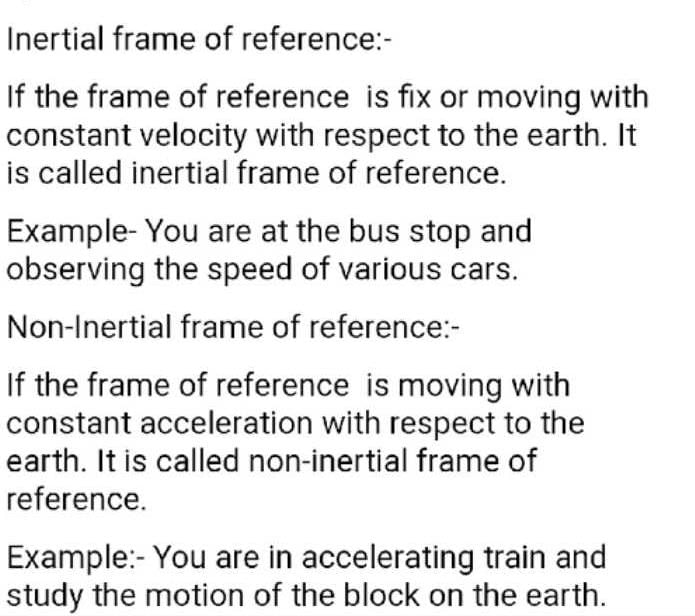NEET Exam > NEET Questions > Difference between inertial and non inertial ...
Start Learning for Free
Difference between inertial and non inertial frame?
Most Upvoted Answer
Difference between inertial and non inertial frame?

Community Answer
Difference between inertial and non inertial frame?
Inertial vs Non-Inertial Frames
In physics, frames of reference are used to describe the motion of an object. An inertial frame of reference is one in which Newton's first law of motion holds true, meaning an object will remain at rest or in uniform motion unless acted upon by an external force. On the other hand, a non-inertial frame of reference is one in which Newton's first law does not hold true due to the presence of acceleration or rotation.
Inertial Frame
- In an inertial frame, Newton's laws of motion are valid without any need for additional forces.
- The frame is not accelerating or rotating with respect to any other frame of reference.
- Examples of inertial frames include a car moving at a constant speed on a straight road or an airplane cruising at a constant altitude.
Non-Inertial Frame
- In a non-inertial frame, fictitious forces such as centrifugal force or Coriolis force may need to be introduced to explain the motion of objects.
- These frames are accelerating or rotating relative to an inertial frame.
- Examples of non-inertial frames include a car taking a sharp turn or a rotating platform.
Differences
- Inertial frames follow Newton's laws without any additional forces, while non-inertial frames may require fictitious forces.
- Inertial frames are not accelerating or rotating, whereas non-inertial frames are.
- Objects in inertial frames move with constant velocity unless acted upon by an external force, while objects in non-inertial frames may experience apparent forces due to acceleration or rotation.
Understanding the distinction between inertial and non-inertial frames is crucial in accurately describing the motion of objects in different scenarios.
In physics, frames of reference are used to describe the motion of an object. An inertial frame of reference is one in which Newton's first law of motion holds true, meaning an object will remain at rest or in uniform motion unless acted upon by an external force. On the other hand, a non-inertial frame of reference is one in which Newton's first law does not hold true due to the presence of acceleration or rotation.
Inertial Frame
- In an inertial frame, Newton's laws of motion are valid without any need for additional forces.
- The frame is not accelerating or rotating with respect to any other frame of reference.
- Examples of inertial frames include a car moving at a constant speed on a straight road or an airplane cruising at a constant altitude.
Non-Inertial Frame
- In a non-inertial frame, fictitious forces such as centrifugal force or Coriolis force may need to be introduced to explain the motion of objects.
- These frames are accelerating or rotating relative to an inertial frame.
- Examples of non-inertial frames include a car taking a sharp turn or a rotating platform.
Differences
- Inertial frames follow Newton's laws without any additional forces, while non-inertial frames may require fictitious forces.
- Inertial frames are not accelerating or rotating, whereas non-inertial frames are.
- Objects in inertial frames move with constant velocity unless acted upon by an external force, while objects in non-inertial frames may experience apparent forces due to acceleration or rotation.
Understanding the distinction between inertial and non-inertial frames is crucial in accurately describing the motion of objects in different scenarios.

|
Explore Courses for NEET exam
|

|
Similar NEET Doubts
Question Description
Difference between inertial and non inertial frame? for NEET 2025 is part of NEET preparation. The Question and answers have been prepared according to the NEET exam syllabus. Information about Difference between inertial and non inertial frame? covers all topics & solutions for NEET 2025 Exam. Find important definitions, questions, meanings, examples, exercises and tests below for Difference between inertial and non inertial frame?.
Difference between inertial and non inertial frame? for NEET 2025 is part of NEET preparation. The Question and answers have been prepared according to the NEET exam syllabus. Information about Difference between inertial and non inertial frame? covers all topics & solutions for NEET 2025 Exam. Find important definitions, questions, meanings, examples, exercises and tests below for Difference between inertial and non inertial frame?.
Solutions for Difference between inertial and non inertial frame? in English & in Hindi are available as part of our courses for NEET.
Download more important topics, notes, lectures and mock test series for NEET Exam by signing up for free.
Here you can find the meaning of Difference between inertial and non inertial frame? defined & explained in the simplest way possible. Besides giving the explanation of
Difference between inertial and non inertial frame?, a detailed solution for Difference between inertial and non inertial frame? has been provided alongside types of Difference between inertial and non inertial frame? theory, EduRev gives you an
ample number of questions to practice Difference between inertial and non inertial frame? tests, examples and also practice NEET tests.

|
Explore Courses for NEET exam
|

|
Signup to solve all Doubts
Signup to see your scores go up within 7 days! Learn & Practice with 1000+ FREE Notes, Videos & Tests.






















